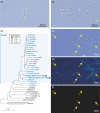Novel Cross-domain Symbiosis between Candidatus Patescibacteria and Hydrogenotrophic Methanogenic Archaea Methanospirillum Discovered in a Methanogenic Ecosystem
- PMID: 36372432
- PMCID: PMC9763046
- DOI: 10.1264/jsme2.ME22063
Novel Cross-domain Symbiosis between Candidatus Patescibacteria and Hydrogenotrophic Methanogenic Archaea Methanospirillum Discovered in a Methanogenic Ecosystem
Abstract
To identify novel cross-domain symbiosis between Candidatus Patescibacteria and Archaea, we performed fluorescence in situ hybridization (FISH) on enrichment cultures derived from methanogenic bioreactor sludge with the newly designed 32-520-1066 probe targeting the family-level uncultured clade 32-520/UBA5633 lineage in the class Ca. Paceibacteria. All FISH-detectable 32-520/UBA5633 cells were attached to Methanospirillum, indicating high host specificity. Transmission electron microscopy observations revealed 32-520/UBA5633-like cells that were specifically adherent to the plug structure of Methanospirillum-like rod-shaped cells. The metagenome-assembled genomes of 32-520/UBA5633 encoded unique gene clusters comprising pilin signal peptides and type IV pilins. These results provide novel insights into unseen symbiosis between Ca. Patescibacteria and Archaea.
Keywords: 32-520/UBA5633; Candidate Phyla Radiation (CPR) superphylum; Candidatus Patescibacteria; Methanospirillum; cross-domain symbiosis.
Figures



References
-
- Albers, S.V., and Jarrell, K.F. (2018) The archaellum: an update on the unique archaeal motility structure. Trends Microbiol 26: 351–362. - PubMed
-
- Altschul, S.F., Gish, W., Miller, W., Myers, E.W., and Lipman, D.J. (1990) Basic local alignment search tool. J Mol Biol 215: 403–410. - PubMed
-
- Brown, C.T., Hug, L.A., Thomas, B.C., Sharon, I., Castelle, C.J., Singh, A., et al. (2015) Unusual biology across a group comprising more than 15% of domain Bacteria. Nature 523: 208–211. - PubMed

